Occupation Actor Name Pedro Cordoba Resting place Holy Cross Cemetery | Years active 1915–1951 Role Actor | |
 | ||
Born September 28, 1881 ( 1881-09-28 ) New York City, USA Died September 16, 1950, Sunland Spouse Eleanor M. Nolan (m. 1928–1950), Antoinette Glover (m. 1917–1921) Children Colette de Cordoba, Michael de Cordoba Movies Saboteur, Carmen, The Ghost Breakers, Condemned to Live, Blood and Sand Similar People William C deMille, Kathryn Adams Doty, Cecil B DeMille, Billy Curtis, Lew Landers | ||
Pedro de Cordoba (September 28, 1881 – September 16, 1950) was an American actor.
Contents
Biography
De Cordoba was born in New York City to parents who were French and Cuban in origin. He was a classically trained theatre actor who confessed he did not enjoy appearing in silent films nearly as much as he liked working on stage, but his career during the silent film era was extensive. His first film was Cecil B. DeMille's version of Carmen (1915), and he soon became a popular leading man in Hollywood. His Broadway career cast him with such stage actresses as Jane Cowl and Katharine Cornell.
Later, his deeply resonant speaking voice made him perfectly suited to talking pictures, and his film career continued, unlike many silent film stars. He enjoyed a career as a busy character actor in Hollywood, from the 1930s through to the end of his life. He was most often cast as aristocratic, or clerical characters of Hispanic origin, as in The Keys of the Kingdom (1944), because of his last name as well as his royal bearing. On rare occasions, he would be cast in the role of a villain. His "living skeleton" sideshow character hides fugitive Robert Cummings (and Priscilla Lane) in his carnival wagon overnight in the Alfred Hitchcock film Saboteur (1942).
He was a devout Catholic and was very well read and knowledgeable about the Catholic faith, and served for a time as president of the Catholic Actors Guild of America. The last film in which he appeared, a political drama set in an unnamed South American dictatorship, Crisis (1950), was released shortly after his death.
